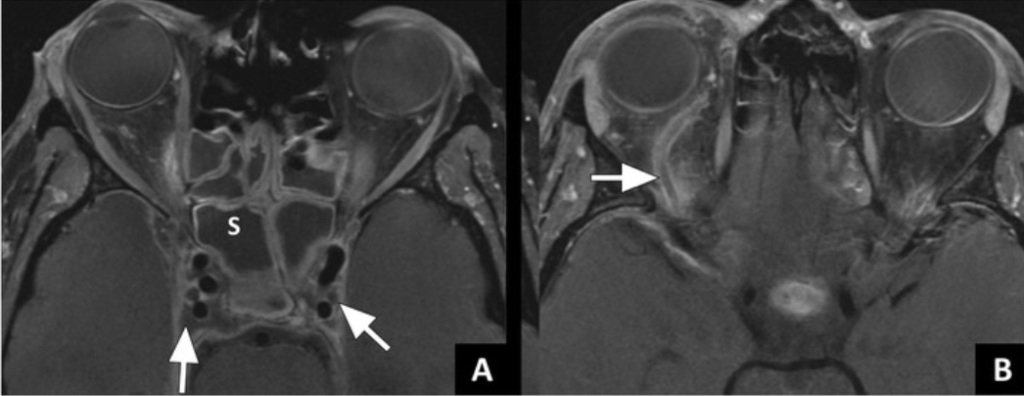Introduction
Cavernous sinus thrombosis (CST) is a serious and complex condition involving the formation of a blood clot within the cavernous sinus, a cavernous structure located at the base of the skull. This condition can lead to significant morbidity and requires prompt diagnosis and treatment. This article provides a comprehensive overview of cavernous sinus thrombosis, including its etiology, clinical presentation, diagnostic approaches, treatment options, and prognosis.
Understanding Cavernous Sinus Thrombosis
Anatomy of the Cavernous Sinus
The cavernous sinus is a pair of venous sinuses located on either side of the sella turcica, which houses the pituitary gland. It is a crucial part of the cranial venous system, and its significance is highlighted by its intricate anatomy. The sinus contains several critical structures, including cranial nerves (III, IV, V1, V2, and VI) and the internal carotid artery. Due to its anatomical position, disorders affecting the cavernous sinus can have wide-ranging neurological implications.
Pathophysiology of Cavernous Sinus Thrombosis
Cavernous sinus thrombosis occurs when a blood clot forms within the cavernous sinus. This can result from several underlying conditions, including infections, malignancies, or trauma. The clot can obstruct venous drainage from the eye and brain, leading to increased intracranial pressure and potentially severe complications.
Causes and Risk Factors
1. Infections: The most common cause of cavernous sinus thrombosis is the spread of infection from adjacent structures, particularly the sinuses or teeth. Infections such as sinusitis or facial cellulitis can progress to involve the cavernous sinus, leading to thrombosis.
2. Malignancies: Tumors in or near the cavernous sinus can obstruct venous drainage and lead to thrombosis.
3. Trauma: Head trauma, particularly involving the face or skull base, can predispose individuals to cavernous sinus thrombosis.
4. Hypercoagulable States: Conditions that predispose to excessive clotting, such as genetic disorders, pregnancy, or use of oral contraceptives, can also contribute to the development of cavernous sinus thrombosis.
Clinical Presentation
Symptoms of Cavernous Sinus Thrombosis
The symptoms of cavernous sinus thrombosis can vary depending on the extent of the clot and the structures involved. Common symptoms include:
- Ocular Signs: Proptosis (bulging of the eye), ophthalmoplegia (paralysis of eye muscles), and visual disturbances due to compression of the cranial nerves.
- Neurological Deficits: Headache, altered consciousness, or signs of increased intracranial pressure.
- Systemic Symptoms: Fever and signs of systemic infection, particularly if the thrombosis is secondary to an infection.
Diagnosis
Diagnosing cavernous sinus thrombosis involves a combination of clinical evaluation and imaging studies.
1. Imaging Studies:
- CT Scan: A non-contrast CT scan can initially identify abnormal density in the cavernous sinus.
- MRI: An MRI is more sensitive and can provide detailed information on the extent of the thrombosis and involvement of surrounding structures. MRI with contrast can better visualize the clot and assess the vascular structures.
2. Lumbar Puncture: Although less commonly used, lumbar puncture can help assess for signs of increased intracranial pressure or infection.
3. Blood Tests:
- Complete Blood Count (CBC): To assess for signs of infection or inflammation.
- Coagulation Profile: To identify any underlying hypercoagulable conditions.

Cavernous Sinus Thrombosis: An In-Depth Exploration
Treatment Approaches
Antibiotic Therapy for Cavernous Sinus Thrombosis
Antibiotic therapy is crucial when cavernous sinus thrombosis is associated with an infection. The choice of antibiotic depends on the suspected causative organism and may include broad-spectrum antibiotics initially. For more specific treatment, cultures and sensitivity tests should guide the choice of antibiotics. Common choices include:
- Vancomycin: Effective against Gram-positive organisms, including MRSA.
- Ceftriaxone: Broad-spectrum coverage for Gram-negative organisms.
- Metronidazole: Particularly useful if anaerobic bacteria are suspected.
External Link: For more detailed information on antibiotics used in treating infections related to cavernous sinus thrombosis, consult resources such as The New England Journal of Medicine.
Anticoagulation Therapy
In cases where the thrombosis is not secondary to an infection but rather due to a hypercoagulable state, anticoagulation therapy may be necessary. This treatment helps prevent further clot formation and resolve the existing clot. Medications such as heparin and warfarin are commonly used.
Surgical Interventions
In severe cases, surgical intervention may be required to relieve pressure on the cranial nerves or to address the underlying cause of the thrombosis. Surgical options depend on the individual case and may involve drainage of abscesses or removal of tumors.
Prognosis and Long-Term Outcomes
The prognosis for cavernous sinus thrombosis varies depending on the underlying cause, the extent of the thrombosis, and the timeliness of treatment. Early diagnosis and treatment are critical for improving outcomes. Patients may experience long-term complications such as chronic pain, visual impairment, or neurological deficits, but with appropriate management, many can achieve a good recovery.
Conclusion
Cavernous sinus thrombosis is a potentially life-threatening condition that requires prompt and effective management. Understanding the underlying causes, recognizing the clinical presentation, and employing appropriate diagnostic and therapeutic strategies are essential for improving patient outcomes. Whether due to infections, malignancies, or other factors, the successful management of cavernous sinus thrombosis relies on a multidisciplinary approach involving antibiotics, anticoagulation, and, if necessary, surgical interventions.
For further reading and resources on cavernous sinus thrombosis, you may refer to Mayo Clinic’s overview of sinus conditions.

